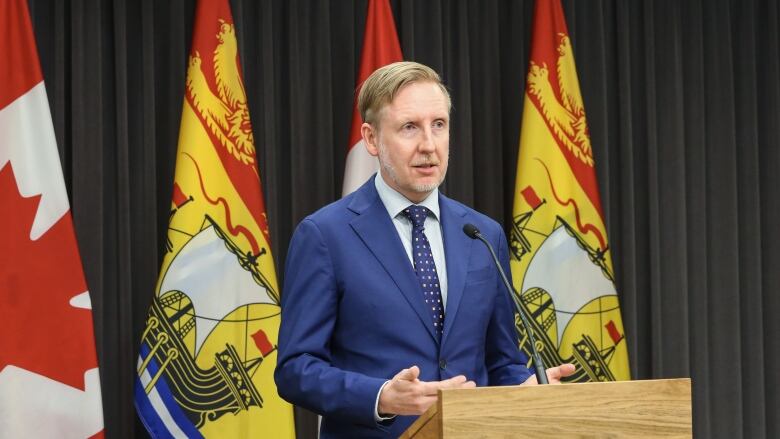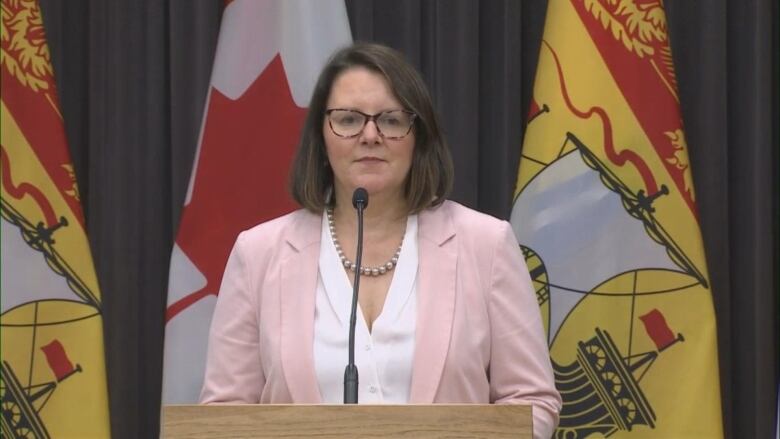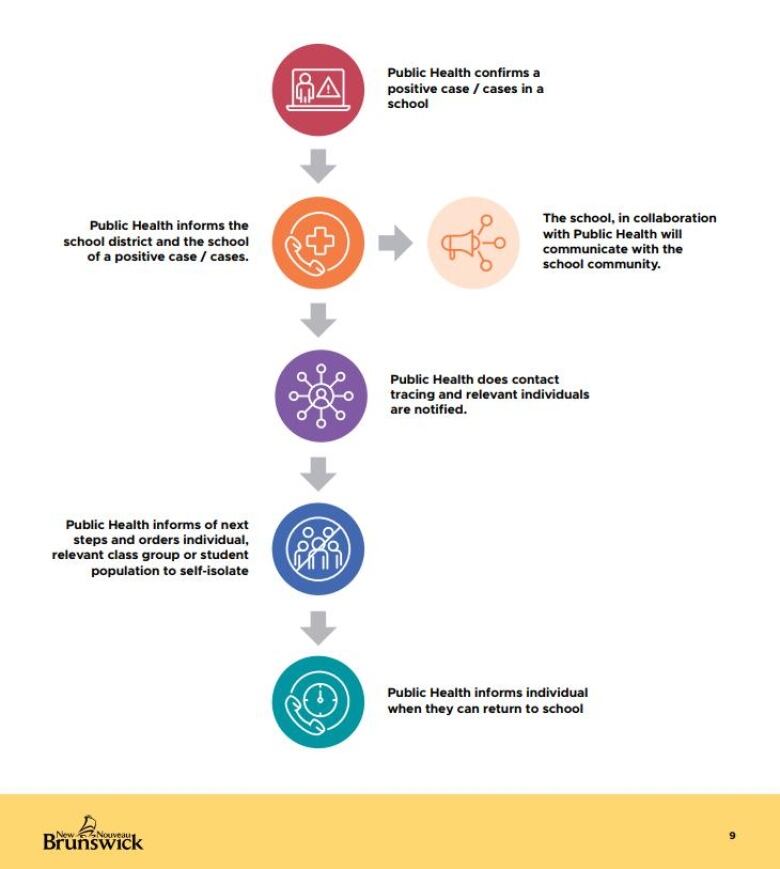New Brunswick back-to-school plan includes mask details, outbreak management plan
Physical education directives have not been confirmed yet, wind instruments and singing prohibited

New Brunswick will makemasks mandatory for students in grades 6 to 12 when they aren't in classrooms and will encourage younger students towear them as well.
All students and staff will need to bring a mask to school every day, the province announced Thursday at a briefing on back-to-school plans held Thursday by Education Minister Dominic Cardy and Jennifer Russell, the chief medical officer of health.
Parents should not count on being told if a case of COVID-19 shows up at their child's school.
And no matter what recovery phase the province is in, learning will continue full time.
"Our intention is to keep the school systems open as long as Dr. Russell lets us,"Cardy said.
"We've got to keep educating our kids. We cannot let years and years go by. Otherwise we would be creating a lost generation. I don't think any of us want that."
New details about school life
The plan fills in some details not addressed when the governmentrevealed in early June how it hoped to get everyone back to school in September, despite the pandemic.
All school buildings were closed March 13, two days after New Brunswick recorded its first presumptive case of COVID-19.
The 16-page school plan says no masks will be required in class for any age group, with one caveat: for grades 9 to 12, masks are not required in class unless in scenarios where they can't keep a one-metre distance.
A student who becomes ill during the school day must wear a mask until picked up. And a student who is ill must stay home.
"Teachers will be able to work with students on an individual basis to make sure they're able to make up for any work they have missed in class ... this is nothing new for our education system," Cardy said.
Students in grades 6 to 12 will have to disinfect their own desks and chairs when they leave class to go home or to another room, on top of the desks and chairs being cleaned daily.
The plan also bans wind instruments and singing but does not have finalized physical education directives.

Thursday marked the first day of regular twice-a-week media conferences led byCardy.
The updates will take place at 2:30 p.m. on Tuesdays and Thursdays through Sept. 3. Students start going back to school on Sept. 8.
"I want this Thursday to be a beginning of the process of talking with the public and having it be a conversation," Cardy said earlier this week.
At the news conference, Russell outlined what would happen "when, not if" there's a confirmed case within the student and staff population. She saidif there's a case in a particular school, not every parentconnected to that school will be informed.
"You have to trust in the process and how our regional teams and Public Health are going to be managing the outbreak," Russell said.
"If you hear of an outbreak at your [child's] school and you don't hear from Public Health that is a good thing."
Outbreak management
The plan says a total school shutdown might not be necessary with one or more cases within the student and staff population.
If there is a case, Public Health will be in charge of contact tracing and will decide who needs to isolate whether it's one or more people, the whole class, several classes or the whole school.
The plan says classroom "bubbles" and maintaining physical distancing between those classrooms will help Public Health with contact tracing and deciding who might have been exposed.

The plan says it's up to the parents and students to monitor for symptoms before going to school.
Russell said it is important for parents to check in on their kids every day to make sure they're not feeling any symptoms. This is the same for staff and teachers, she said. If anyone is feeling unwell, they should stay home. She did not mention any at-work monitoring for teachers and staff, aside from self-monitoring.
If parents get an "urgent call" about their child, they're required to pick them up as soon as possible.
The plan says there will be "increased support" for students whose health conditions may make them vulnerable,but it does not elaborate on that except to say if a student has health concerns, parents should consult their doctors, inform the school for "appropriate planning."
If there's an outbreak and all students have to do remote learning:
- Students in kindergarten to Grade 2 will get "paper-based" learning with daily check ins.
- Students in grades 3 to 5 will get paper-based learning with some technology and "routine teaching engagement."
- Students in grades 6 to 12 will get technology based learning with regular teaching.
Mask plans for buses
Under the school plan, not all students will have to wear masks on a school bus. If older students wear masks, they can share seats.
The plan allows only one child per two-passenger seat for kindergarten to Grade 5, except members of the same household. No masks are required on buses for kindergarten to Grade 5.

But for grades 6 to 12, masks are required if there is more than one child per seat, and those students will have to wear a mask when entering and exiting the bus. They can remove the mask if they're sitting alone or with members of the same household.
The plan says busing schedules might have to be changed. Bus routes are under the authority of the districts.
Classroom sizes confirmed
Class sizes will only be smaller for kindergarten to Grade 6.
In June, the province said students in kindergarten to Grade 8 will not have to socially distance within the classroom, and each class is effectively a "bubble."
This plan confirms class sizes: For kindergarten to Grade 2, class sizes will be as close to 15 as possible. For Grades 3 to 5, sizes will be as close to 22 as possible.
Grades 6 to 8 will have regular class sizes, and there will be also no change to grades 9 to 12 class sizes either.
In common areas, those classroom bubbles must be two metres apart. So a student from Grade 3 will have to keep two metres from students from Grade 4, for example.
Rotating class attendance
Students in grades 9 to 12 are registered in different combinations of classes, so a classroom bubble is not possible for them. This is why those students will generally be attending school physically every other day.
When they're in school, students will be one metre apart inside the classroom.
High schools that can maintain physical distancing at all times won't have to have alternating attendance, the plan says.
On Tuesday, Russell announcedpublic places will be able to reduce physical distancing requirements to one metre from two metres, provided people wear masks.
This plan has grades 9 to 12students one-metre apart and not wearing masks.
On Thursday, Russell said Public Health endorses this plan despite the variation.
"With public health being involved in all of the advice. We are confident we can do this safely. We're balancing the risk of keeping the kids home indefinitely during the pandemic, and allowing them to have as normal an education experience as possible."

Shared materials and school access
The plan says all shared materials must be disinfected after each use. Things that can't be disinfected will only be used by one student.
Cleaning supplies are being secured by school districts, the plan says, and washrooms and change rooms must be cleaned at least three times a day.
There will be no water fountains, and bottle-filling stations are being installed.
Districts will try to limit flow of staff between schools, and access to school will be limited. Parents will only be able to enter school if they have an appointment or need to pick up kids.
They will have to wear masks and follow physical distancing.
Existing ventilation systems have been "determined to meet health requirements," the plan says.
Extra-curriculars
Breakfast and snack programs will continue.
Physical education directives have not been confirmed yet, but wind instruments and singing will be prohibited.
Class trips are not necessarily cancelled either, as long as physical distancing can be maintained.













_(720p).jpg)


 OFFICIAL HD MUSIC VIDEO.jpg)
.jpg)



























































































